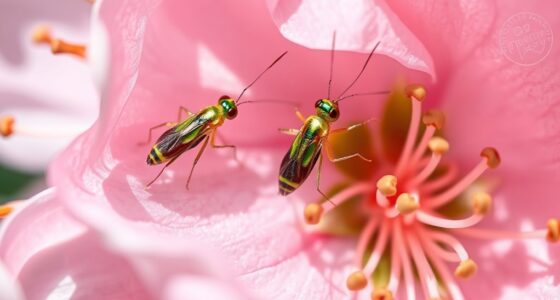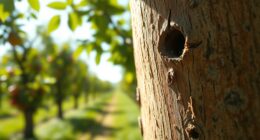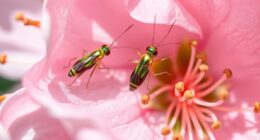Leafrollers on apples and pears are tiny caterpillars that roll or tie leaves around themselves, often hiding inside. You should regularly inspect your trees for curled leaves and frass signs, especially during early growth stages. Effective management includes monitoring closely, practicing orchard sanitation, and using biological controls or targeted insecticides when necessary. Staying alert early can prevent significant damage, and staying informed will help you better control these pests as you continue caring for your trees.
Key Takeaways
- Leafrollers are tiny caterpillars that damage apples and pears by rolling or tying leaves with frass inside.
- Regular scouting for leafrolled leaves and frass helps detect infestations early.
- Management includes cultural practices, biological controls, and targeted chemical treatments at egg hatch.
- Orchard sanitation and pruning reduce overwintering larvae and hideouts for leafrollers.
- Early, precise intervention minimizes damage and supports sustainable pest control methods.

As apples and pears begin to develop, leafrollers become a common pest to watch for. These tiny caterpillars can cause considerable damage if left unchecked, so it’s essential to stay vigilant early in the growing season. One of the most effective ways to manage leafroller infestations is through integrated pest management (IPM). IPM combines multiple strategies—cultural, biological, and chemical—to reduce pest populations while minimizing environmental impact. By monitoring pest activity regularly, you can determine the right time to intervene and apply control measures precisely when needed, avoiding unnecessary pesticide use.
Start by inspecting your trees frequently, especially during bud break and the early stages of fruit development. Look for signs of leafroller activity, such as rolled or tied leaves with frass (caterpillar droppings) inside. Leafrollers tend to hide within these leaf rolls, so careful scouting is critical. When you detect early signs, you can implement crop protection strategies that target the pests effectively. Biological controls, such as introducing natural enemies like parasitic wasps, can help keep leafroller populations in check without harming beneficial insects. These predators often target the larvae within the leaf rolls, reducing the need for chemical interventions.
Inspect trees regularly during bud break for leafrolled leaves and frass to catch leafroller early.
Chemical control should be a last resort but can be integrated into your overall crop protection strategies when pest pressure is high. Use targeted, low-impact insecticides that are specific to leafrollers, and apply them at the appropriate timing—usually when the larvae are most vulnerable, just after egg hatch. Proper timing ensures maximum effectiveness and minimizes impacts on non-target species. Additionally, proper pruning and orchard sanitation can help reduce overwintering sites for leafrollers, disrupting their life cycle and decreasing future populations.
Implementing crop protection strategies that focus on cultural practices, biological controls, and judicious chemical use can considerably reduce leafroller damage. Crop rotation and removing debris from the orchard floor can also help eliminate overwintering larvae, further decreasing the likelihood of severe infestations. Remember, the key to managing leafrollers effectively is consistency and early intervention. By integrating these pest management tactics into your routine, you’ll protect your apples and pears from damage, ensuring healthy, high-quality fruit at harvest. Staying proactive and informed about pest activity allows you to make smarter decisions, ultimately leading to a more sustainable and productive orchard. Incorporating essential oils for pest management can also be a natural alternative to chemical controls, promoting a healthier environment.
Frequently Asked Questions
How Can I Prevent Leafrollers Before They Appear?
To prevent leafrollers before they appear, you should implement cultural practices like pruning to remove hiding spots and improve airflow. Consider planting resistant varieties that are less attractive to leafrollers. Additionally, monitor your trees regularly for early signs of activity, and apply appropriate insecticides at the first indication of pest presence. These proactive steps help keep leafrollers at bay and protect your fruit crops effectively.
Are There Organic Methods to Control Leafroller Infestations?
Organic options offer effective, eco-friendly enforcement against leafroller infestations. You can employ biological control by releasing natural predators like Trichogramma wasps, which target leafroller eggs. Additionally, applying organic sprays such as Bacillus thuringiensis or neem oil can help halt larvae development. These natural, non-toxic methods provide powerful, pest-proof protection while preserving your orchard’s health and harmony.
When Is the Best Time to Apply Insecticides?
You should apply insecticides during the early spring or late summer, when leafroller activity peaks, to maximize effectiveness. Timing considerations are essential; target the larval stages before they burrow into fruit or leaves. Use insecticide options like spinosad or bacillus thuringiensis, which are effective and suitable for organic control. Always follow label instructions and monitor pest activity to guarantee proper timing and minimize impacts on beneficial insects.
Do Leafrollers Affect Fruit Quality or Taste?
Think of leafrollers as tiny pirates sneaking into your orchard. Yes, they can cause fruit blemishes, which might not spoil the taste but definitely affect harvest quality. I once saw a batch of apples with minor scars, but the flavor was still perfect. While leafrollers don’t directly change the fruit’s taste, their damage can make your fruit less appealing and reduce its market value.
Can Leafrollers Cause Long-Term Damage to Trees?
Yes, leafrollers can cause long-term damage to your trees if not managed properly. They weaken the tree’s resilience by damaging leaves and shoots, which hampers photosynthesis and growth. To prevent lasting harm, you should focus on pest identification early, so you can apply targeted control measures. Regular monitoring helps catch infestations early, ensuring your trees stay healthy and productive over the years.
Conclusion
By staying vigilant against leafrollers, you become the gardener guarding a delicate tapestry. Each careful step you take is like weaving a shield over your orchard’s dreams, ensuring the fruit’s promise isn’t lost to unseen threats. Remember, your watchfulness is the steady hand guiding nature’s dance, turning small efforts into a harvest of abundance. With patience and care, you nurture not just apples and pears, but a legacy rooted in resilience and hope.









